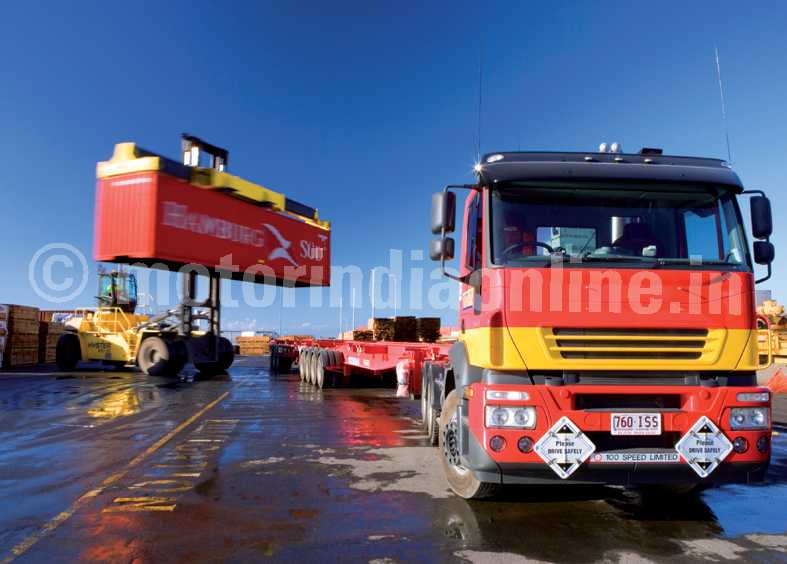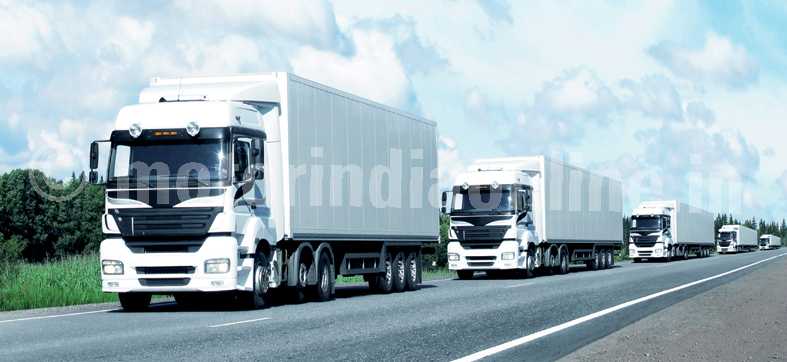By A. Peer Mohamed, Past President, Pondicherry Goods Transporters’ Association
Logistics management is increasingly becoming a topic of interest among academicians and practitioners since it leads to reduced operational costs, improved delivery and higher customer satisfaction.

The global logistics industry is estimated to be worth $300 billion. Though most of the large service providers are headquartered in Europe, the biggest market is the US, which captures about one-third of the world market. The global industry is characterized by high costs of operations, low margins, shortage of talent, infrastructural bottlenecks, demand from clients for investing in technology and providing one-stop solutions to all their needs, and consolidation through acquisitions, mergers and alliances.
Though the industry in India is still in its infancy, there is immense potential for growth. The Indian logistics industry is currently plagued with low demand, poor infrastructure, high costs, government regulations, etc. However, it is going to turn around on the back of robust GDP growth, globalization, FDI in logistics and increasing government support.
This paper highlights the current state of the industry, including the dynamics and opportunities for growth in India and at the global level, based on the findings of different surveys.
Logistics and supply chain management (SCM) as an area of research has been attracting increasing attention from academicians and practitioners over the last two decades since it may lead to reduced operational costs, improved delivery performance and increased customer satisfaction levels, thereby making an organization more competitive in terms of cost, quality, delivery and flexibility. The importance of logistics and SCM is increasing also due to globalization as more and more multinational companies (MNCs) are sourcing, manufacturing and distributing on a global scale, making their supply chains very complex to manage.
However, outsourcing logistics activities to experienced logistics service providers (LSPs), also known as third-party logistics (3PL) providers, may enable companies to get very efficient and customized logistical support while themselves focusing on the core organizational activities.
Today, there are many large multinational LSPs that offer complete supply chain solutions across many diverse countries in terms of their socio-economic and political environments. Apart from core logistical activities such as transportation and warehousing, LSPs also offer value-added services such as customs clearance, freight forwarding, import/export management, inventory management, assembly/installation, packaging and labelling, distribution, after-sales support, reverse logistics and so on. By outsourcing logistics, companies can leverage the expertise of LSPs while concentrating on their core competencies.
Currently the annual logistics cost of the world is about $3.5 trillion. For any country, the annual logistics cost varies between nine per cent and 20 per cent of GDP. For the US it is about nine per cent.
The US-based Armstrong & Associates, Inc. tracks the issues and trends in the world logistics market and in the local market, in particular, in their annual surveys of top 25 global LSPs. According to the firm, the global logistics market sizes in 1992, 1996 and 2000 were $10 billion, $25 billion and $56 billion respectively. In 2003 and 2004, the corresponding figures were $270 billion and $333 billion, registering high growth rates.
Though most of the large LSPs are headquartered in Europe, the US logistics market is the largest in the world capturing one-third of the world logistics market. In 2003, it was about $80 billion. In 2004 it grew to $89 billion, and in 2005, it registered an impressive growth rate of 16 per cent to cross the $100 billion-mark for the first time and reach $103.7 billion (Foster and Armstrong, 2004, 2005, 2006). However, considering the fact that the logistics market in the US is about 10 per cent of its annual logistics cost (Foster and Armstrong, 2006), there is still immense potential for growth of 3PL in the US in particular, and in the world in general.

The Indian scenario
The annual logistics cost in India is estimated to be 14 per cent of the GDP, which translates into $140 billion assuming GDP of India to be slightly over $1 trillion. Out of this $140 billion logistics cost, almost 99 per cent is accounted for by the unorganized sector (such as owners of less than five trucks, affiliated to a broker or a transport company, small warehouse operators, customs brokers, freight forwarders, etc.), and slightly more than one per cent, i.e., approximately $1.5 billion, is contributed by the organized sector. So, one can see that the logistics industry in India is in a nascent stage.
However, the industry is growing at a fast pace, and if India can bring down its logistics cost from 14 per cent to nine per cent of the GDP, as in the US, savings to the tune of $50 billion will be realized at the current GDP level, making Indian goods more competitive in the global market. Moreover, growth in the logistics sector would imply improved service delivery and customer satisfaction leading to growth of export of Indian goods and potential for creation of job opportunities.
Of course there are problems within the Indian logistics industry which make it unattractive for investments and also create entry barriers. Logistics is a high-cost, low-margin business. The problem of organized players is compounded by unfair competition with unorganized players, who can get away without paying taxes and following operating norms stipulated in the Motor Vehicles Act such as the quality of drivers and vehicles, volume and weight restrictions, etc.
Economies of scale are absent in the Indian logistics industry. Even the organized sector that contributes slightly more than one per cent of the logistics cost is highly fragmented. The differential sales tax structure also brought in diseconomies of scale. Though VAT has been implemented since April 1, 2005, failure in implementation of a uniform VAT structure across different States has let the problem persist even today.
Apart from the non-uniform tax structure, Indian LSPs have to pay numerous other taxes and octrois and face multiple check posts and police harassment. High costs of operation and delays involved in compliance with the varying documentation requirements of different States make the business unattractive. On an average, a vehicle on Indian roads loses 24-48 hours in complying with paperwork and formalities at different check posts en route to a destination. Fuel worth $2.5 billion is spent annually on waiting at check posts. A vehicle that costs $30,000 pays $7,500 per annum in the form of various taxes, which include excise on fuel. This is why freight cost is a major component of the cost of a product in India.
Poor physical and communications infrastructure is another deterrent to attracting investments in the logistics sector. Road transportation accounts for more than 60 per cent of inland transportation of goods, and highways that constitute 1.4 per cent of the total road network, carry 40 per cent of the freight movement by roadways. Slow movement of cargo due to bad road conditions, multiple check-posts and documentation requirements, congestion at seaports due to inadequate infrastructure, bureaucracy, red-tapism and delay in government clearances, together with unreliable power supply and slow banking transactions, make it difficult for exporters to meet the deadlines for their international customers. To expedite shipments, they have to book as airfreight rather than sea freight. This adds to the cost of shipments making them uncompetitive in international markets.
Moreover, many large shipping liners avoid Indian ports for long turnaround times due to delays in loading/unloading and hence Indian exporters have to resort to transshipments at ports such as Singapore, Dubai and Colombo. This adds to the cost of shipments and also delays delivery.

Future prospects
Despite problems, the Indian logistics industry is growing at 20 per cent vis-à-vis the average world industry growth of 10 per cent. Since the organized sector accounts for merely one per cent of the annual logistics cost, there is immense potential for growth of the sector.
Many large Indian corporates such as Tata and Reliance Industries have been attracted by the potential of this sector and have established the logistics divisions. They started providing in-house logistics services, and soon sensing the growth of the market, have started providing services to other corporates as well.
Large express cargo and courier companies have also started logistics operations. These companies enjoy the advantage of already having a large asset base and an all-India distribution network. Some large distributors have also forayed into the logistics business for their clients. Since logistics service can be provided without assets, there is growing interest among entrepreneurs to venture into this business.
The Indian economy is growing at over nine per cent for the last couple of years as compared to the world GDP growth rate of three per cent. This implies more outputs and more demand for specialized logistics services.
The Government has its focus on infrastructure development in the country. Examples include the Golden Quadrilateral project, east-west and north-south corridors (connecting four major metros), Free Trade and Warehousing Zones (FTWZs) in line with the Special Economic Zones (SEZs) with 100 per cent foreign direct investment and public-private partnerships (PPPs) in infrastructure development. Infrastructure development is expected to boost investments in the logistics sector.
As far as the Indian industry is concerned, logistics managers of user firms need to realize that, with supply chains getting more and more complex, outsourcing part or all of their logistical activities to experienced LSPs will help reduce their overheads, streamline supply chains, reduce costs and improve service delivery. The organizational interests should be put above vested interests, if any. They need to realize that organized LSPs are professionals who will maintain confidentiality of sensitive client information.
The Government should also focus on developing infrastructure and encourage public-private partnerships in investments in infrastructure. Highway projects such as the Golden Quadrilateral are already underway. Private investments in inland containerized transportation by railroad, which was a monopoly of Container Corporation of India Ltd. (CONCOR), a subsidiary of Indian Railways, until recently, have been allowed. 100% FDI is also allowed in Free Trade and Warehousing Zones (FTWZs) to create necessary trade-related infrastructure to facilitate import and export of goods and services.
The Government may create logistics SEZs or logistics hubs with concessions in land and tax rates. Incentive schemes may also be extended for construction of modern automated warehouses and cold chains. Access to cheap capital should be made available to LSPs for investments in infrastructure, enabling them to extend longer credit periods to their clients and supplementing their working capital.
The Government may also create a uniform tax structure and do away with multiple check points and documentation requirements, which would lead to speedier delivery of cargo. To generate awareness, it may organize seminars, workshops and exhibitions to bring representatives of logistics users, service providers and government under one roof, and also sponsor courses in leading Indian institutes to attract talent. Growth of the logistics industry in India will not only contribute to GDP but also generate employment.